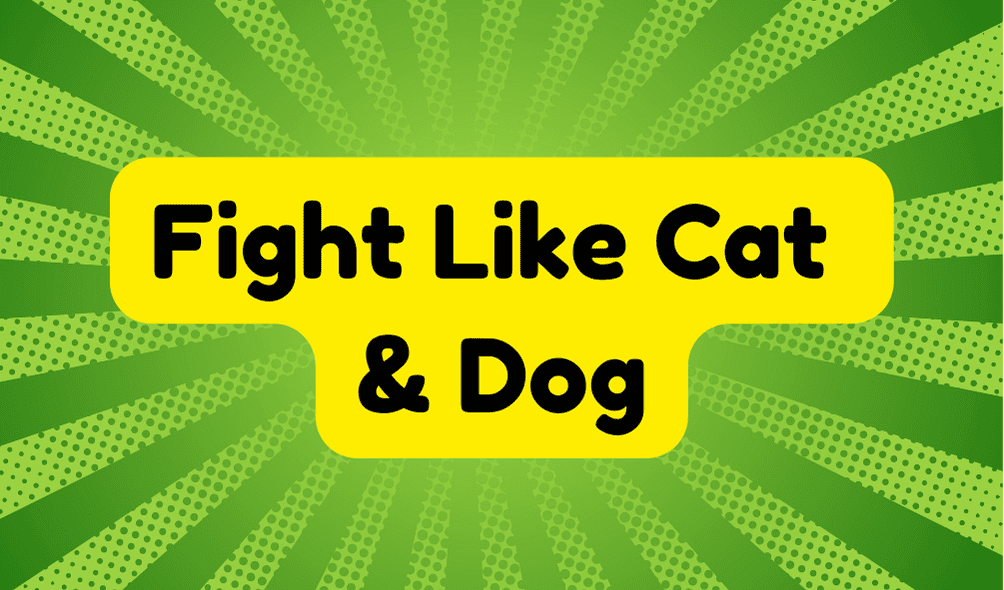When you say someone "fights like cats and dogs," you're referring to intense and often bitter arguments. This phrase first appeared around 1611 and draws from the well-known animosity between cats and dogs. While it highlights severe disputes in relationships, it also points to the emotional turmoil these conflicts create. Miscommunication can escalate tensions, leading to unyielding disagreements. Understanding these dynamics is essential for resolving disputes and fostering healthier interactions. Instead of just bickering over trivial issues, recognizing the roots of conflict can inspire conversations that matter. There's more to uncover about this phrase and its implications.
Synonyms
Conflict can manifest in various ways, and the phrase "fight like cat and dog" captures one of its most intense forms. If you're familiar with this phrase, you know it reflects deep divisions. Synonyms help paint a broader picture of this emotional turmoil, highlighting the nature of these conflicts. Here are a few:
- Argue fiercely
- Bicker incessantly
- Battle openly
- Clash violently
- Quarrel relentlessly
Each of these terms emphasizes the struggle involved and the challenge of conflict resolution. It's essential to recognize that such intensity often leads to misunderstandings and unresolved issues, leaving you feeling drained. When you acknowledge these phrases and the implications they carry, you empower yourself to seek better communication strategies and navigate tense situations with more grace and understanding.
Example of Sentences
Intense disagreements often manifest in relationships, and the expression "fight like cat and dog" perfectly encapsulates this dynamic. You might find yourself relating to these famous examples that reveal the emotional implications of such conflicts:
- A married couple fought like cat and dog throughout their relationship.
- Politicians often fight like cat and dog during elections, showcasing their vehement disagreements.
- Young children engaged in fights like cats and dogs over simple misunderstandings.
- Best friends experienced fights like cats and dogs when tackling touchy subjects.
- Twin girls, who seemed inseparable outdoors, fought like cats and dogs within their home.
These sentences illustrate how intense fighting reveals deeper emotional rifts, often leading to unresolved tensions and strained relationships. Understanding this can help you navigate your own conflicts more effectively.
Origin
The origin of the phrase "fight like cat and dog" is a bit murky, with its roots linked to the domestication of both animals. This expression likely evolved from the historical context of cats and dogs clashing when they share living quarters. Records show it first appeared in a Globe Theater performance in 1611, but its acceptance fluctuated between a disaster and a romantic depiction.
Here's a brief look at its evolution:
| Element | Detail |
|---|---|
| Initial Use | 1611 in a performance |
| Animals in Focus | Cats and dogs, fierce challengers |
| Reaction | Mixed critical reception |
| Meaning Shift | Reflects ongoing, intense disputes |
As you see, this idiom captures the essence of conflict with historical nuances still relevant today.
Collocations
Understanding the phrase "fight like cat and dog" leads us to explore its various collocations that enhance its meaning. These collocations reflect the emotional intensity of the cat-dog relationship, often highlighting playful fights that mask deeper disputes. Consider these phrases:
- Argue like cats and dogs
- Fight tooth and nail
- Clash heads with fervor
- Bicker constantly and intensely
- Squabble over trivial matters
Each expression illustrates how conflicts can escalate from minor disagreements into intense exchanges. You might find it interesting that while playful fights can be amusing, they also reveal a complex dynamic underlying relationships. Recognizing these collocations helps you grasp the broader implications of what it means to "fight like cat and dog," adding depth to your understanding of interpersonal conflicts.
How to Use in Everyday Language
When you want to describe ongoing disputes between individuals, using the phrase "fight like cat and dog" can effectively convey the level of conflict involved. This expression works well in various settings, from casual conversations to more serious discussions about relationships. It highlights how emotional expressions can spiral into intense confrontations, often signaling a deeper issue at play. While it's easy to toss around this phrase, be mindful of its implications regarding conflict resolution; understanding what fuels these fights could lead to healthier communication. So, instead of merely labeling disagreements, consider if you can steer the conversation towards a constructive path. Ultimately, using this phrase invites reflection on conflict dynamics rather than simply chronicling chaos.
Why Is It Still Relevant Today?
Fighting like cat and dog remains relevant today because it encapsulates the visceral nature of human conflict in a relatable way. This phrase's cultural significance endures, illustrating how miscommunication fuels disputes. In a world aiming for conflict resolution, recognizing this dynamic can spark innovative dialogue.
| Aspects of Conflict | Impact |
|---|---|
| Emotional turmoil | High tension |
| Lack of understanding | Miscommunication |
| Jealousy | Escalates issues |
| Relationship strain | Deteriorates bonds |







